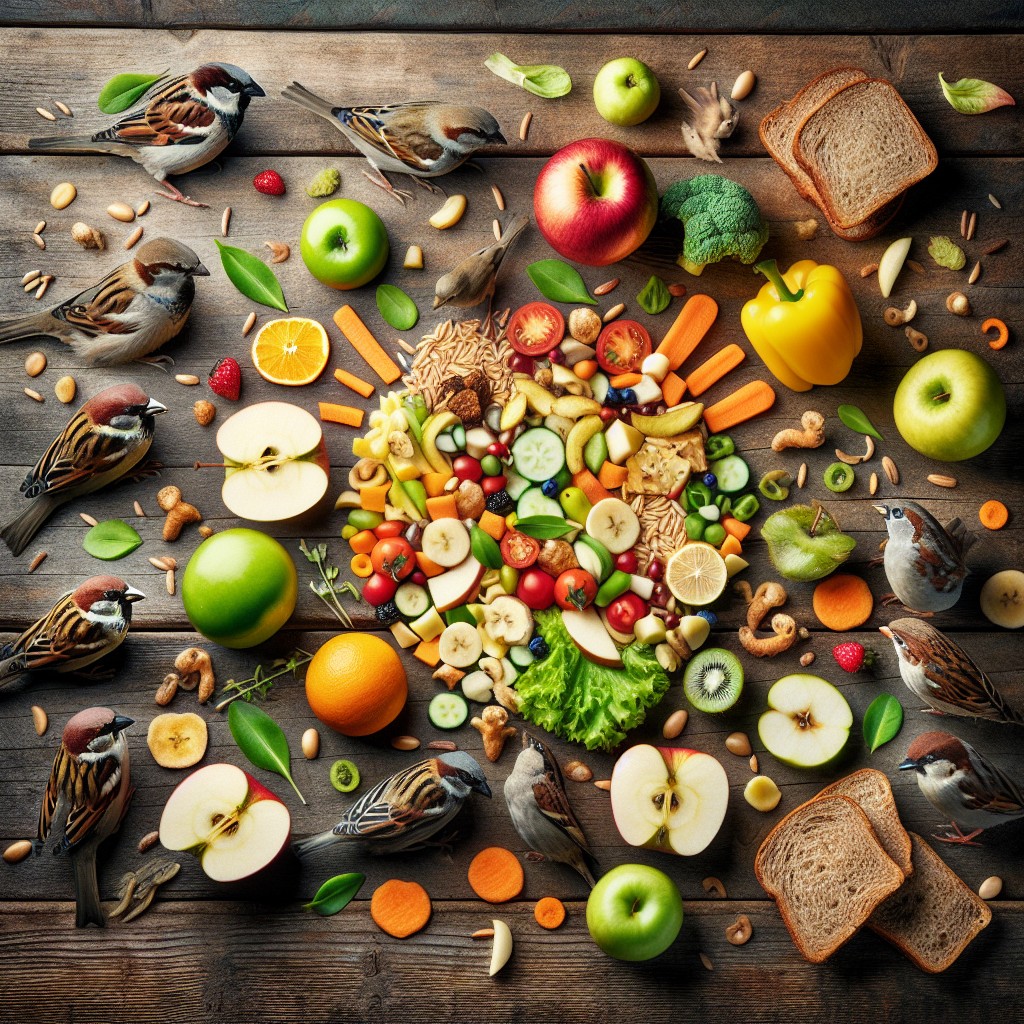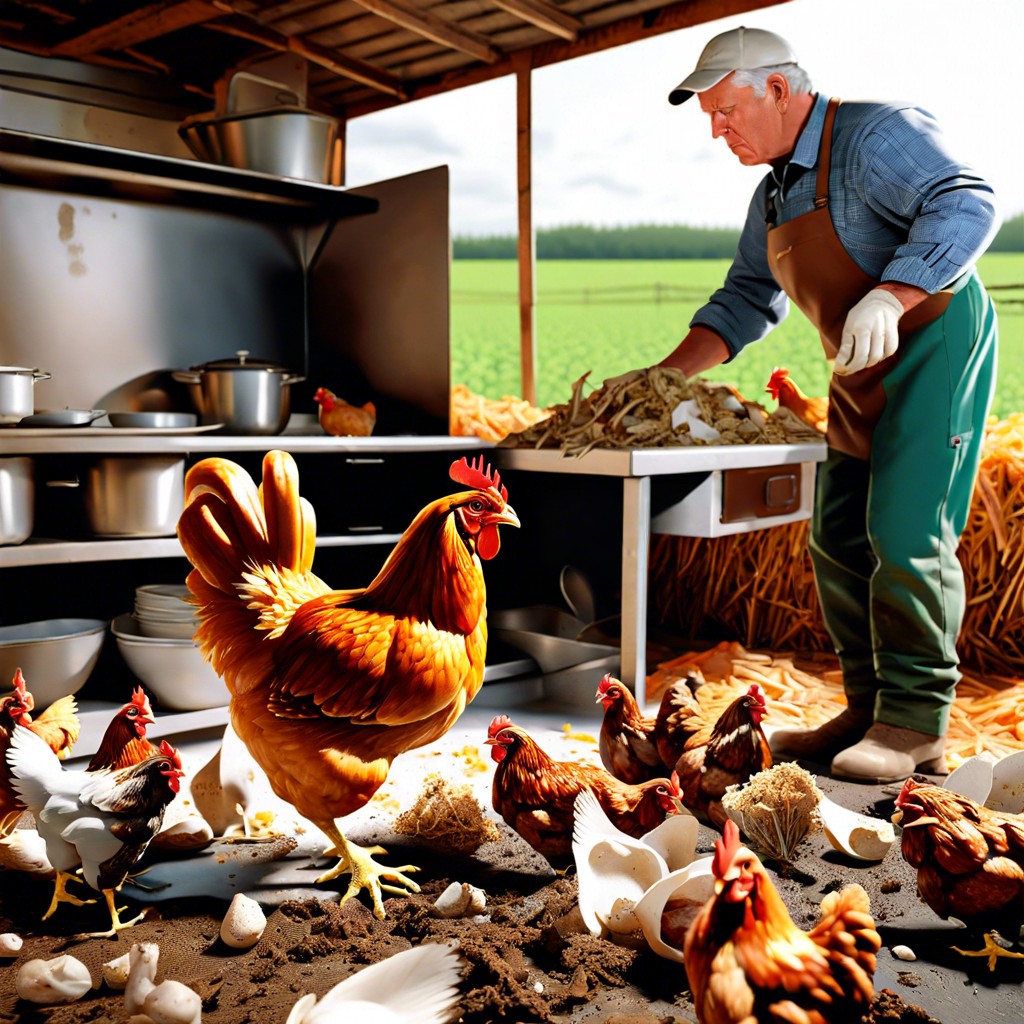Last updated on
Discover the variety of human foods that birds can safely enjoy and which ones to avoid.
Key takeaways:
- Birds can safely eat cooked rice, oats, fruits, vegetables, and eggshells.
- Cut larger food into bite-sized pieces to prevent choking.
- Avoid avocados, chocolate, caffeine, salt, fat, sugar, and xylitol.
- Different feeders at different levels cater to bird species’ preferences.
- Placing feeders at different levels reduces competition and supports healthier feeding habits.
What's Inside
Types of Kitchen Scraps That Can Be Safely Offered to Birds

Grains play a pivotal role in a bird’s diet, and many of the varieties we consume are also suitable for our feathered friends. Cooked rice, whether white or brown, provides valuable sustenance without posing a choking hazard. Similarly, oats, either whole or rolled, serve as a nutritious snack.
When it comes to bread, it’s essential to remember that while birds will eat it, it offers minimal nutritional value and should only be offered in moderation.
Beyond grains, fruits are a delicious treat that many birds relish. Offer up slices of apples, pears, or bananas, ensuring they are free from any harmful seeds or pits. Likewise, vegetables such as sweet corn, peas, or grated carrots are packed with vitamins and can be an appetizing addition to their diet.
For a serious protein boost, eggshells are an excellent option. Sterilized by boiling and then crushed, they can be strewn across the bird table to supplement the birds’ calcium intake, crucial for strong eggshells during breeding season.
Finally, remember that moderation is key. While kitchen scraps can diversify a bird’s diet, they should only complement their primary food sources such as seeds, nuts, and naturally found insects, ensuring a balanced diet for optimal health.
How to Feed Scraps to Birds
When offering scraps to our feathered friends, it’s essential to ensure that they’re accessible and safe for consumption. Break or cut larger pieces into bite-sized chunks to prevent choking hazards. Distribute these morsels on a clean tray or platform feeder to allow birds to pick safely and comfortably.
Scatter seeds or crumbs on the ground for ground-feeding species, but be mindful to do so in an area that’s not easily accessible to predators.
For wet scraps like fruit pieces, a hanging feeder with a solid base or a bird table with drainage can help to keep the offerings from spoiling too quickly. Always remove any uneaten food before it has a chance to rot, as spoiled offerings can harbor bacteria harmful to birds.
In colder months, fat from unsalted meat or homemade suet cakes can provide high-energy sustenance for the birds. It should be offered in mesh feeders or suet cages. Regularly clean feeders with hot water and a brush to prevent the spread of disease. Introduce these treats gradually and in moderation to ensure a balanced diet for the birds and to avoid attracting unwanted pests.
The Nutritional Value of Kitchen Scraps and Pantry Grains
Offering kitchen scraps to birds can be comparable to providing a buffet of assorted delicacies, each packed with its unique nutritional benefits. Fresh fruit peels, such as apples and pears, are excellent sources of vitamins, while grains from your pantry, like rice and quinoa, offer complex carbohydrates and essential proteins.
Cooked pasta and rice can be a delightful treat, delivering a quick energy boost. Unsweetened cereals are also a favorite, giving birds a crunch packed with fiber. When it comes to protein, cooked eggs and eggshells can be a powerhouse food, providing essential amino acids and calcium.
It’s important to note that moderation is key, as an overreliance on scraps can lead to an unbalanced diet. Always ensure that kitchen scraps complement their natural foraging and aren’t their sole food source.
Are Any Human Foods Unsafe for Birds?
Just as certain foods are off-limits for pets like dogs and cats, some common human foods can be harmful, or even lethal, to birds. It’s crucial to be aware of these to ensure our feathered friends remain healthy.
Firstly, avocados contain persin, a substance that can induce heart failure in birds. Chocolate is another no-go; it contains both caffeine and theobromine, which can cause vomiting, diarrhea, and a potentially fatal increase in heart rate in birds. Similarly, caffeine in coffee or soda can adversely affect a bird’s cardiac function.
Moreover, birds are highly sensitive to salt/sodium, which is often found in copious amounts in processed foods. Too much salt can lead to excessive thirst, dehydration, kidney dysfunction, and even death. Foods high in fat and sugar should also be avoided as they can lead to obesity and a host of health issues in birds.
Xylitol, an artificial sweetener found in many sugar-free products, can also be extremely toxic to birds. When ingested, it can cause a rapid release of insulin, hypoglycemia, and liver failure. It’s best to keep all sugar-free products well away from birds.
Finally, the pits and seeds of fruits such as apples, cherries, peaches, and apricots contain cyanide, which is harmless to humans in small quantities but can be toxic to birds.
The key takeaway? Stick to bird-safe foods, and when in doubt, err on the side of caution to keep birds safe from dietary dangers.
Why Are Different Feeders Placed At Different Levels?
Birds come in varied shapes and sizes, with preferences and behaviors as diverse as their appearances. Placing feeders at different levels caters to the natural feeding habits of different species. Ground feeders like sparrows and doves prefer to eat at ground level, while finches and cardinals often seek food at higher elevations, feeling safer from predators when perched at a height. Elevated feeders can also deter some ground predators and pests, such as squirrels and rats.
Different levels can mimic birds’ natural environments. For example, woodpeckers and nuthatches are climbers and are more inclined to visit feeders placed against tree trunks or on tree branches. Higher levels can reflect the canopy layer of a forest, ideal for canopy-dwelling birds, whereas lower levels replicate the understory.
These feeding strategies can reduce competition at the feeders, ensuring that more timid birds have a chance to eat without being bullied by more aggressive species and that every bird can find a comfortable spot to dine. Additionally, feeding birds at their preferred level encourages healthier, stress-free feeding, which can lead to better survival rates, especially in harsh weather conditions when food is scarce.
Continue reading:



